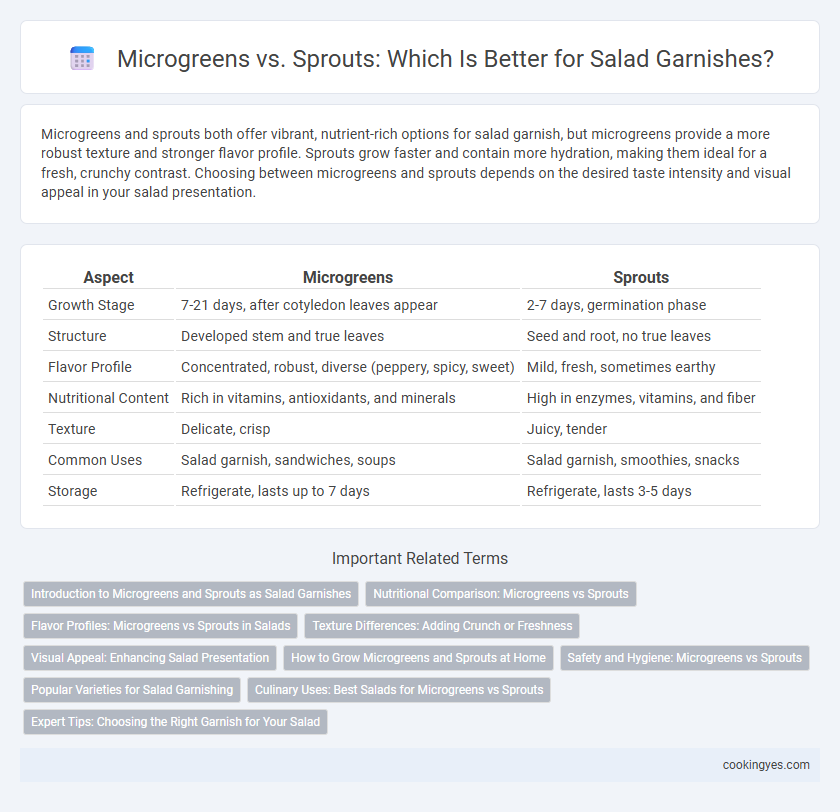Microgreens and sprouts both offer vibrant, nutrient-rich options for salad garnish, but microgreens provide a more robust texture and stronger flavor profile. Sprouts grow faster and contain more hydration, making them ideal for a fresh, crunchy contrast. Choosing between microgreens and sprouts depends on the desired taste intensity and visual appeal in your salad presentation.
Table of Comparison
| Aspect | Microgreens | Sprouts |
|---|---|---|
| Growth Stage | 7-21 days, after cotyledon leaves appear | 2-7 days, germination phase |
| Structure | Developed stem and true leaves | Seed and root, no true leaves |
| Flavor Profile | Concentrated, robust, diverse (peppery, spicy, sweet) | Mild, fresh, sometimes earthy |
| Nutritional Content | Rich in vitamins, antioxidants, and minerals | High in enzymes, vitamins, and fiber |
| Texture | Delicate, crisp | Juicy, tender |
| Common Uses | Salad garnish, sandwiches, soups | Salad garnish, smoothies, snacks |
| Storage | Refrigerate, lasts up to 7 days | Refrigerate, lasts 3-5 days |
Introduction to Microgreens and Sprouts as Salad Garnishes
Microgreens and sprouts both serve as vibrant salad garnishes but differ in growth stage and flavor intensity. Microgreens are young seedlings harvested after the first true leaves develop, offering concentrated nutrients and a variety of textures. Sprouts are germinated seeds harvested earlier, delivering a tender crunch and mild flavors that enhance salad freshness and visual appeal.
Nutritional Comparison: Microgreens vs Sprouts
Microgreens contain higher concentrations of vitamins C, E, and K, as well as beta-carotene, compared to sprouts, making them a more nutrient-dense option for salad garnishes. Sprouts, while rich in enzymes and antioxidants, generally have lower overall vitamin and mineral content than microgreens. Choosing microgreens boosts the salad's nutritional profile with enhanced antioxidants, fiber, and essential micronutrients.
Flavor Profiles: Microgreens vs Sprouts in Salads
Microgreens offer a concentrated, intense flavor with vibrant notes ranging from spicy arugula to sweet basil, enhancing salad complexity. Sprouts have a milder, fresher taste with subtle crunch, often contributing a crisp, delicate texture without overpowering other ingredients. Choosing microgreens or sprouts influences the overall salad experience by balancing boldness and freshness in flavor profiles.
Texture Differences: Adding Crunch or Freshness
Microgreens provide a tender yet crisp texture that adds a delicate crunch to salad garnishes, enhancing freshness without overpowering other ingredients. Sprouts offer a juicier, softer bite with a slight crunch, contributing a burst of moisture and mild earthiness. Choosing microgreens or sprouts depends on whether you prefer a crisp snap or a fresh, succulent element to elevate your salad's texture profile.
Visual Appeal: Enhancing Salad Presentation
Microgreens offer a vibrant range of colors and delicate leaf shapes that instantly elevate salad presentation, providing a fresh and sophisticated visual appeal. Sprouts, with their tender stems and clustered growth, add a unique texture and a burst of subtle green hues that complement various salad ingredients. Using microgreens or sprouts as a garnish enhances the overall aesthetics by introducing contrast, depth, and an appetizing freshness to salad dishes.
How to Grow Microgreens and Sprouts at Home
Microgreens and sprouts both enhance salads with vibrant flavors and nutrients, but differ in growth methods; microgreens require soil or a growing medium and typically take 7-14 days to harvest, while sprouts grow in water and are ready in 3-7 days. To grow microgreens at home, sprinkle seeds evenly on a shallow tray filled with potting soil, keep them moist and place under indirect sunlight or a grow light until they develop true leaves. For sprouts, soak seeds overnight, drain and rinse them twice daily in a sprouting jar or mesh container, and harvest once they reach the desired length, ensuring proper airflow to prevent mold.
Safety and Hygiene: Microgreens vs Sprouts
Microgreens offer enhanced safety and hygiene compared to sprouts, as they grow in soil or soil substitutes, reducing the risk of bacterial contamination common in water-grown sprouts. Sprouts require warm, humid conditions that can promote the growth of harmful bacteria like Salmonella and E. coli, leading to recalls and foodborne illness outbreaks. Proper handling and thorough washing of microgreens contribute to a safer option for salad garnishing, making them preferable for health-conscious consumers.
Popular Varieties for Salad Garnishing
Microgreens commonly used for salad garnishing include arugula, basil, cilantro, and radish, known for their intense flavors and vibrant colors that enhance presentation. Sprouts such as alfalfa, mung bean, and broccoli are favored for their crisp texture and mild taste, adding a fresh crunch to salads. Both microgreens and sprouts provide essential nutrients and elevate the visual appeal of salads, but microgreens are often preferred for their more complex flavors and diverse varieties.
Culinary Uses: Best Salads for Microgreens vs Sprouts
Microgreens add vibrant color and intense flavor, enhancing gourmet salads such as arugula, beet, and mixed green blends, while sprouts offer a crisp, fresh texture ideal for Asian-inspired and vegetable-based salads like mung bean or alfalfa sprouts. Microgreens, rich in nutrients, complement delicate greens, tomatoes, and cucumbers, elevating presentation and taste complexity. Sprouts, with their crunchy bite, pair well with robust, hearty ingredients, providing a refreshing contrast in dishes like noodle salads or grain bowls.
Expert Tips: Choosing the Right Garnish for Your Salad
Microgreens offer a vibrant, nutrient-dense garnish with a concentrated flavor profile ideal for enhancing salads, while sprouts provide a crisp texture and subtle taste perfect for layering complexity. Experts recommend selecting microgreens like radish or sunflower for bold, peppery notes, whereas alfalfa and mung bean sprouts add mild crunch without overpowering greens. To maximize freshness and visual appeal, choose garnishes harvested within a week and store them in a cool, humid environment before plating.
Microgreens vs sprouts for salad garnish Infographic

 cookingyes.com
cookingyes.com